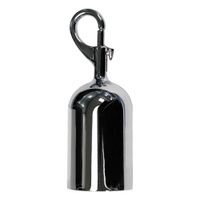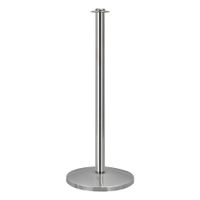Call +(254) 703 030 000 / 751 483 999 / 721 704 777
- Home
- Security
- Access Barriers Crowd Control
- Rope Barriers
.....Read More
Frequently Asked Questions
What are rope barriers used for?
Rope barriers, often seen in public and private spaces, serve multiple purposes. Primarily, they are used for crowd control, guiding people in an orderly fashion and preventing chaos in areas with high foot traffic, such as airports, banks, museums, and theaters. By delineating pathways, they help manage queues efficiently, ensuring that people move in a systematic manner and reducing the likelihood of congestion.
In addition to crowd management, rope barriers are employed to restrict access to certain areas. They can indicate that a particular section is off-limits, whether for security reasons, maintenance, or to protect exhibits and displays. This is particularly useful in museums or galleries where certain artworks or installations need to be safeguarded from close contact.
Rope barriers also play a significant role in event management. They are used to create VIP sections, manage red carpet events, and organize entry and exit points at concerts, conferences, and other large gatherings. Their presence adds a level of sophistication and order, enhancing the overall experience for attendees.
Furthermore, rope barriers contribute to aesthetic appeal. Available in various colors, materials, and styles, they can complement the decor of a venue, adding a touch of elegance and formality. This is especially true in upscale settings like hotels, casinos, and exclusive clubs, where the design and presentation are crucial.
Overall, rope barriers are versatile tools that combine functionality with style, making them indispensable in both everyday operations and special events.
How do rope barriers work?
Rope barriers, also known as stanchions, are crowd control tools used to guide or restrict the movement of people in various settings such as events, banks, museums, and airports. They consist of posts (stanchions) and ropes or belts that connect these posts, forming a barrier or pathway.
The posts are typically made of metal or plastic and have a weighted base to ensure stability. The ropes, often made of velvet, braided fabric, or retractable belts, attach to the posts using hooks or clips. The ropes can be easily detached and reattached, allowing for quick reconfiguration of the barrier layout.
Rope barriers work by creating a visual and physical boundary that directs foot traffic. They help organize queues, prevent unauthorized access to certain areas, and maintain order in crowded environments. The barriers are strategically placed to guide people along a desired path, ensuring efficient flow and minimizing congestion.
In addition to their functional role, rope barriers can also enhance the aesthetic appeal of a venue. The choice of materials, colors, and finishes can complement the decor and create a sense of exclusivity or formality.
Overall, rope barriers are a versatile and effective solution for managing crowds, providing both practical and visual benefits in various settings.
What materials are rope barriers made from?
Rope barriers are typically made from a variety of materials, each chosen for its specific properties and aesthetic appeal. Common materials include:
1. **Velvet**: Often used in high-end or formal settings, velvet ropes provide a luxurious appearance. They are soft to the touch and available in various colors, with red being the most iconic.
2. **Nylon**: Known for its durability and strength, nylon is a popular choice for rope barriers in both indoor and outdoor settings. It is resistant to wear and tear, making it suitable for high-traffic areas.
3. **Polypropylene**: This synthetic material is lightweight and resistant to moisture, making it ideal for outdoor use. It is also available in a range of colors and can mimic the appearance of natural fibers.
4. **Hemp or Jute**: These natural fibers offer a rustic and organic look, often used in settings that require an eco-friendly or nautical theme. They are strong but can be less durable than synthetic options when exposed to the elements.
5. **Cotton**: Soft and flexible, cotton ropes are used for their aesthetic appeal and are often found in decorative settings. However, they may not be as durable as synthetic materials.
6. **Metallic Cords**: For a modern and sleek appearance, some rope barriers use metallic cords, which can be made from materials like stainless steel or aluminum. These are often used in contemporary or industrial-themed environments.
Each material offers different benefits, such as durability, aesthetic appeal, and suitability for specific environments, allowing for a wide range of applications in various settings.
How do you set up rope barriers?
To set up rope barriers, first determine the area you need to cordon off and measure the space to decide the number of stanchions (posts) required. Typically, stanchions are placed 6 to 8 feet apart.
1. **Select Stanchions and Ropes**: Choose stanchions that suit your event's aesthetic, such as chrome or brass, and select ropes that match in color and style.
2. **Position the Stanchions**: Start by placing the first stanchion at the beginning of the area you want to cordon off. Ensure it is stable and on a flat surface. Continue placing additional stanchions at equal intervals, ensuring they are aligned and stable.
3. **Attach the Ropes**: Begin by attaching one end of the rope to the top hook or clip of the first stanchion. Walk the rope to the next stanchion, ensuring it is taut but not overly tight, and attach it to the next stanchion. Repeat this process until all stanchions are connected.
4. **Adjust for Tension and Alignment**: Once all ropes are attached, check the tension to ensure they are not sagging excessively. Adjust the stanchions as needed to maintain a straight line or desired shape, such as a queue or perimeter.
5. **Secure the Ends**: Ensure the ends of the rope are securely fastened to the final stanchions. If the rope has clips, ensure they are properly latched.
6. **Safety Check**: Walk along the barrier to ensure all stanchions are stable and ropes are secure. Make any necessary adjustments to prevent tripping hazards or instability.
7. **Final Touches**: If needed, add signage or decorative elements to the stanchions to enhance visibility or provide information.
Where can I buy rope barriers?
You can purchase rope barriers from a variety of sources, both online and in physical stores. Here are some options:
1. **Online Retailers**: Websites like Amazon, eBay, and Walmart offer a wide range of rope barriers in different styles and price ranges. You can compare prices, read customer reviews, and choose from various brands.
2. **Specialty Stores**: Companies that specialize in event supplies or crowd control equipment, such as Crowd Control Store, Seton, or Uline, provide a variety of rope barriers. These stores often offer customization options and bulk purchase discounts.
3. **Office Supply Stores**: Chains like Staples or Office Depot sometimes carry rope barriers, especially those designed for office or event use.
4. **Home Improvement Stores**: Large retailers like Home Depot or Lowe’s may have rope barriers, particularly in their event or safety sections.
5. **Event Rental Companies**: If you need rope barriers for a short-term event, consider renting from a local event rental company. They often have a range of styles and can provide setup and takedown services.
6. **Local Retailers**: Check with local hardware stores or specialty shops that might carry rope barriers, especially if you prefer to see the product in person before purchasing.
7. **Direct from Manufacturers**: Some manufacturers sell directly to consumers through their websites, offering competitive pricing and the option to customize orders.
8. **Second-Hand Options**: Platforms like Craigslist or Facebook Marketplace may have used rope barriers at a lower cost.
When purchasing, consider the material, length, and style of the rope barriers to ensure they meet your specific needs.
What are the benefits of using rope barriers?
Rope barriers offer several benefits, making them a popular choice for crowd control and space management. Firstly, they provide an effective way to guide and manage crowds, ensuring orderly queues and preventing chaos in busy areas like airports, banks, and event venues. Their flexibility allows for easy reconfiguration to accommodate different crowd sizes and layouts, making them versatile for various settings.
Aesthetically, rope barriers add a touch of elegance and sophistication, especially when paired with polished stanchions. They are available in various colors and materials, allowing customization to match the decor or theme of an event or venue. This makes them suitable for high-end events, red carpet occasions, and formal gatherings.
Rope barriers are also easy to install and dismantle, offering convenience for temporary setups. They are lightweight and portable, facilitating quick adjustments and storage when not in use. This ease of use is particularly beneficial for venues that frequently change layouts or need to adapt to different events.
Additionally, rope barriers are durable and require minimal maintenance. Made from robust materials, they withstand regular use and environmental factors, ensuring longevity and cost-effectiveness. They also provide a clear visual boundary without being intrusive, maintaining an open and welcoming atmosphere while subtly directing foot traffic.
Safety is another advantage, as rope barriers help prevent accidents by keeping people away from restricted or hazardous areas. They can be used to demarcate zones, ensuring that only authorized personnel access certain sections.
Overall, rope barriers are a practical, stylish, and efficient solution for managing crowds, enhancing safety, and maintaining order in various environments.
How do you maintain and clean rope barriers?
To maintain and clean rope barriers, follow these steps:
1. **Regular Inspection**: Frequently check the ropes and stanchions for wear and tear, fraying, or damage. Ensure the hooks and connectors are secure and functioning properly.
2. **Cleaning the Ropes**:
- **Fabric Ropes**: Use a vacuum with a brush attachment to remove dust and debris. For stains, spot clean with a mild detergent and water solution. Gently scrub with a soft brush, then blot with a clean cloth. Allow to air dry completely.
- **Velvet Ropes**: Use a lint roller to remove dust and lint. For deeper cleaning, use a velvet-specific cleaner or a mild soap solution. Gently dab the area with a damp cloth, then blot dry.
- **Plastic or Vinyl Ropes**: Wipe with a damp cloth and a mild detergent solution. Rinse with a clean, damp cloth and dry with a towel.
3. **Cleaning the Stanchions**:
- **Metal Stanchions**: Use a soft cloth with a non-abrasive cleaner. For stainless steel, use a stainless steel cleaner to prevent rust and maintain shine. Polish with a microfiber cloth.
- **Brass Stanchions**: Use a brass cleaner or a mixture of vinegar and salt. Apply with a soft cloth, rinse, and buff to shine.
- **Plastic Stanchions**: Wipe with a damp cloth and mild detergent. Rinse and dry thoroughly.
4. **Storage**: Store ropes and stanchions in a dry, cool place to prevent moisture damage. Coil ropes loosely to avoid kinks and tangles.
5. **Routine Maintenance**: Tighten any loose screws or fittings and replace any damaged parts promptly to ensure safety and longevity.
By following these steps, rope barriers will remain clean, functional, and visually appealing.


